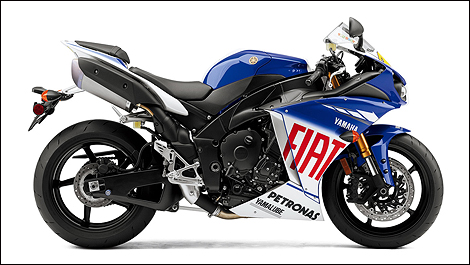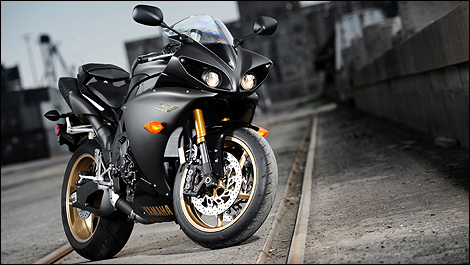When Yamaha announced the all new
2009 R1, (which returns unchanged for 2010 save for colours, an extra $100 added to the MSRP, and a special "Valentino Rossi" model), and mentioned the “Cross plane crankshaft” layout, everyone wanted to understand exactly what this meant in terms of improvements in the behaviour of the beast.
Well, the jury is out: the R1 is clearly the best behaved 2009 litre sportbike when it comes to putting the power down on the ground on aggressive corner exits. And given that every manufacturer is leaving 2009 models pretty well unchanged for 2010, expect a similar advantage in the new year.
 |
| Hail to the Chiefs: the 2009 World Superbike Champion's bike, decorated with the colours of the 2009 World MotoGP Champion. A salute to Ben Spies and Valentino Rossi, from the brand that gave them their championships. This special 2010 model is available in limited quantities, for about one grand more than the more common colour schemes. Hurry, as I suspect they will be gone quickly. |
Yamaha did it by building a better bike, one more suited to its task, rather than trying to out-electronic the competition with features and devices to take command and control of the bike out of the hands of the rider, or by building the most powerful (And usually harder to ride) bike in that category. But the new-gen R1 is not only about the crankshaft, it is also about new ergos and every-day usability.
An effective engine-gearbox combination
The cross plane crankshaft layout is not new. It was resurrected by Yamaha engineers when Valentino Rossi switched away from Honda to Yamaha MotoGP machines for the 2004 season, in response to his demands for a smoother engine, one that would make riding less demanding over race distance, as well as easier on the rear tire. It worked, as the resulting engines won rider championships in 2004, 5, 8, and 9!
Power on paper (182 hp) and on the dyno tells us that the 2009/10 R1 is a little weaker than the 2008 version. Decreasing power in the midst of an arms race did not make sense to me until I rode the bikes and saw that it is the R1’s usable performance, i.e. torque and power, that make a difference, rather than power at the top of the rev range that cannot be used because of wheel spin and attendant loss of traction, and rider fatigue over a race distance.
Gone is the rush of power near the red line that previous R1s are famous for, as torque is now stronger across the whole day-to-day rev range, as well as up near the red line where the power peaks. The new motor does produce enough urge for competent riders to get the machine sideways under hard acceleration without the impending feeling that the bike is about to jump sideways and put you in orbit – just a nice smooth slide that does not require Rossi-like skills to control.
On thing remains intact, the rush of power at high rpm, when you cannot actually feel the drop in power on the street. On the other hand, you can actually feel the increased traction, on the street as well as the track.
 |
| The metallic black finish looks just right on the R1, giving it a stylish, low-key appearance that belies the bikes potential and effectiveness. |

